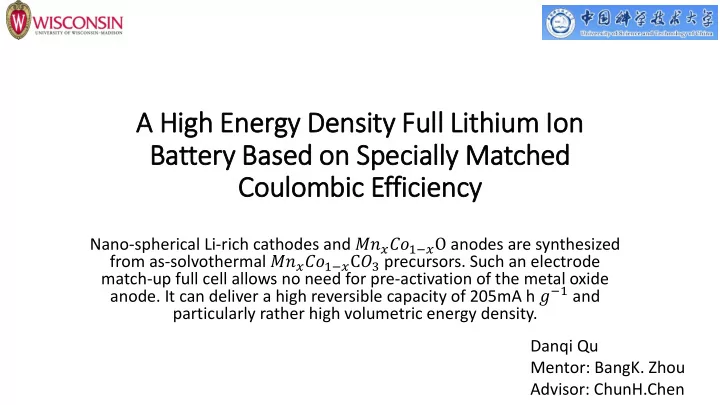

A Hig igh Energy Density Full ll Lit ithium Io Ion Battery ry Based on Specially Matched Coulombic Efficiency Nano-spherical Li-rich cathodes and 𝑁𝑜 𝑦 𝐷𝑝 1−𝑦 O anodes are synthesized from as-solvothermal 𝑁𝑜 𝑦 𝐷𝑝 1−𝑦 C𝑃 3 precursors. Such an electrode match-up full cell allows no need for pre-activation of the metal oxide anode. It can deliver a high reversible capacity of 205mA h −1 and particularly rather high volumetric energy density. Danqi Qu Mentor: BangK. Zhou Advisor: ChunH.Chen
Introduction Commercial cathode materials : LiFeP 𝑃 4 LiM 𝑜 2 𝑃 4 (500Wh/Kg) and ternary materials like NMC(Ni Mn Co) NAC(Ni Al Co) 750-800Wh/Kg Anode materials : graphite is the state-of-the-art material for lithium ion battery. Packing density 1.6g/c 𝑛 3 Specific capacity 350mAh/g Are both insufficient for high capacity power batteries. Transition metal oxides as anode materials for LIB can deliver as high as 700- 900mAh/g
Transition metal oxides are hardly applied in full LIB because their low initial coulombic efficiency(50%-70%) would destroy a big fraction of reversible capacity from the cathode. On the other hand, Li – rich layer-structured cathode materials are found to have much higher reverible capacity(about 250 mAh/g) and energy density(1000Wh/Kg) than the commercial cathodes. But they have drawbacks of low initial coulombic efficiency(about 70%), inferior rate performance and gradual decay of the operating voltage.
Herein, a strategy of coulombic efficiency match-up is adopted to overcome the disadvantages of the first-cycle capacity loss for both Li-rich cathodes and TMO anodes in order to achieve high energy density of the cell! Properties of electrodes LMNO Mn 0.8 Co 0.2 O Graphite 350 345 757 Charge specific capacity (mAh g -1 ) 372 245 1040 Discharge specific capacity (mAh g -1 ) 94.1% 71.0% 72.8% Initial columbic efficiency 2.25 ≈2.50 5.45 Real density (g cm -3 )
The cycling performance at 0.2C current density and the The cycling performance at 0.4A/g current density corresponding coulombic efficiency of LMNO and the corresponding coulombic efficiency of 𝑁𝑜 0.8 𝐷𝑝 0.2 O
Experimental
1. Synthesis the Mn-Co carbonate nanospheres as precursors through a solvothermal method. 2. Synthesis of Li-rich and 𝑁𝑜 𝑦 𝐷𝑝 1−𝑦 O electrode materials. 3. Characterization of materials 4. Electrochemical measurements XRD patterns of 𝑁𝑜 𝑦 𝐷𝑝 1−𝑦 O anodes XRD patterns of Li-rich layer-structured cathodes with different compositions
Results and Discussion The comparison of specific capacity and energy density of the full cells between this work and previously reported ones
TEM images of 𝑁𝑜 0.8 𝐷𝑝 0.2 C𝑃 3 (a) 𝑁𝑜 0.8 𝐷𝑝 0.2 -Oxide intermediate(b) 𝑁𝑜 0.8 𝐷𝑝 0.2 O(c) LMNO(d)
SEM image(a) and enlarge picture(b) of the 𝑁𝑜 0.8 𝐷𝑝 0.2 O electrode after 200 cycles at 0.4 A/g current density
Charge&discharge curves and the comparison of energy density of the two cell
Properties of electrodes LMNO Mn 0.8 Co 0.2 O Graphite 350 345 757 Charge specific capacity (mAh g -1 ) 372 245 1040 Discharge specific capacity (mAh g -1 ) 94.1% 71.0% 72.8% Initial columbic efficiency 2.25 ≈2.50 5.45 Real density (g cm -3 )
Conclusions In summary, several powders of Li-rich cathode and Mn-Co oxide anode materials with tailored microstructures are synthesized. On the cathode side, 0.5L 𝑗 2 Mn 𝑃 3 0.5LiM 𝑜 0.5 N 𝑗 0.5 𝑃 2 shows an initial discharge capacity of 247mAh/g with a coulombic efficiency of 71% and the capacity retention is 95.8% after 130 cycles at 0.2C. Binary transition metal oxide 𝑁𝑜 0.8 𝐷𝑝 0.2 O offers excellent cycling stability and rate performance. The initial reversible capacity is 759mAh/g with a coulombic efficiency of about 72.8% and the capacity retention is 110% after 200 cycles at 0.4Ah/g. The initial charge capacity of the “N - cell” is 363mAh/g, and is approximately equal to the value measured in the LMNO/Li half cell, while the discharge capacity is 205 mAh/g. The capacity retention is as high as 97.5% in the following 20 cycles.
Due to their intrinsic high capacity and the special match-up in coulombic efficiency, such an N-cell demonstrates particularly high volumetric energy density and excellent cycling performance. Further optimization and development of the design and fabrication will lead to new opportunities for higher energy- density batteries. And the next step, we are now doing some work to solve the problem that the operating voltage of Li-rich layer-structured cathode materials will gradually decay with the cycling number increasing.
Thank you for your attention
Recommend
More recommend